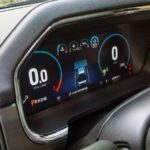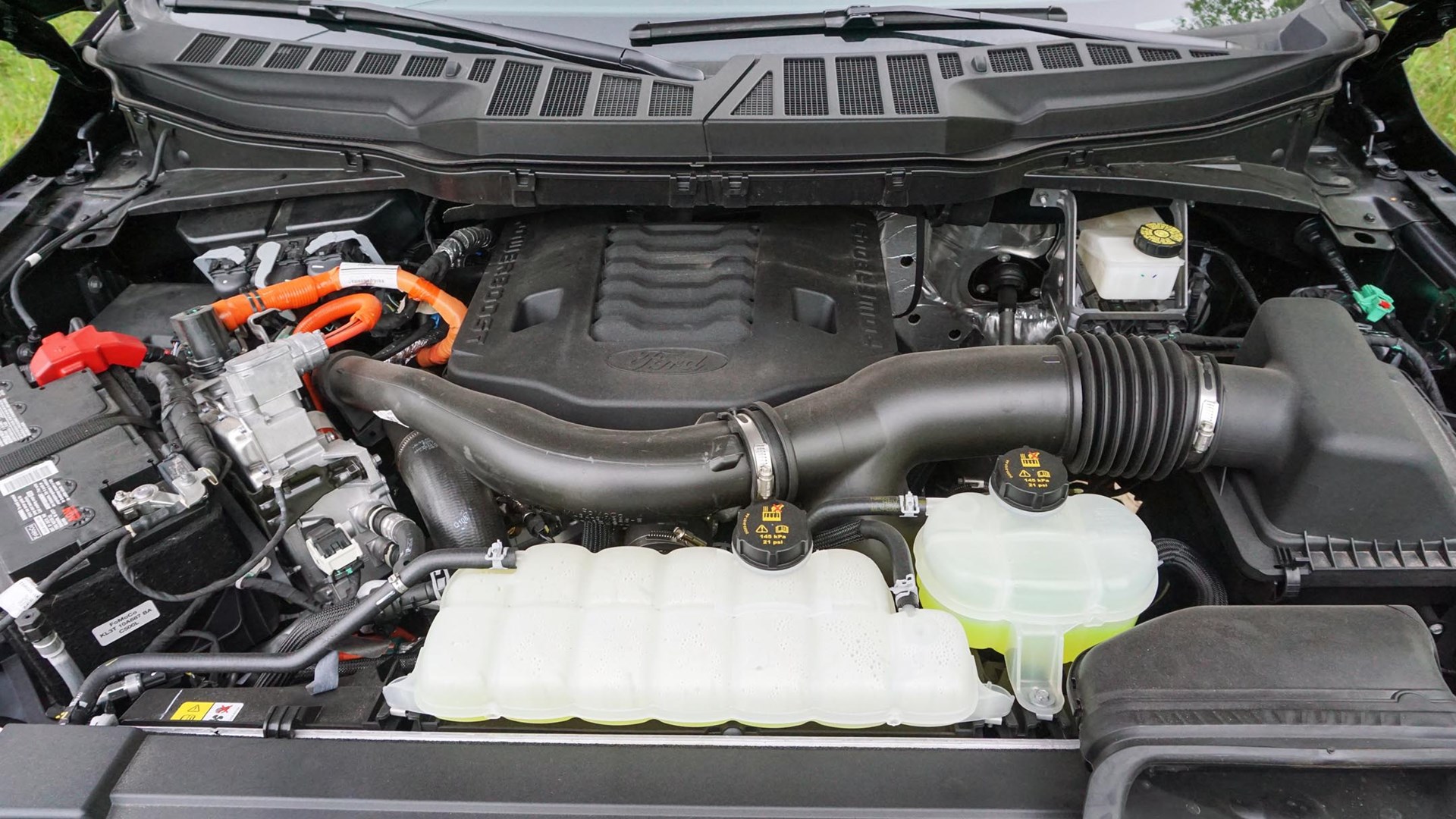It wasn’t supposed to go down like this.
My evaluation of the 2021 Ford F-150 Hybrid was supposed to be an exhaustive one filled with all sorts of truck stuff. I had plans to pick up a load of lumber for a fence project, and head out on an annual camping trip where it would be tested on a moderately difficult off-road trail, used to haul felled trees for firewood, and, since the powertrain works like a built-in generator, run a projector to watch a movie or two by the water – all in the name of delivering the most in-depth review possible.
Unfortunately, the global pandemic had other plans. As if astronomical lumber prices weren’t enough, a province-wide ban on overnight camping on Crown land put the kibosh on the rest of my plans entirely. That left me with little more to do than haul around my sorrows over the course of a week-long test – not exactly the exhaustive regimen I had envisioned for this truck.
It got me thinking, though: more often than not, it’s downtime like this that makes up the everyday life of the average half-ton truck. Sure, they’re ready to work when called upon; but it’s more common to spot them with empty beds than full ones. They’re just as popular among commuters as they are contractors, with bloated fuel bills an accepted reality of the ownership experience whether they’re hard at work or hardly working. But that’s exactly why a little electrification goes a long way, and the 2021 Ford F-150 Hybrid is perfect for those in-between times while still serving up plenty of capability when it’s required.
Power: 10/10
Most of the F-150’s mechanical components carry over to this new generation, with one notable exception: the addition of hybrid power. Forget the Ram 1500’s available mild hybrid setup – the powertrain here actually cuts fuel consumption in a meaningful way. This truck borrows a transmission-mounted 33-kW electric motor and 1.5-kWh lithium-ion battery pack from the fantastic Ford Explorer Hybrid, but pairs them with the brand’s tried-and-true twin-turbocharged 3.5L V6 instead of that SUV’s smaller, naturally aspirated engine.
The result is a whopping 430 hp and 570 lb-ft of torque, both figures far exceeding those of any other F-150 powertrain this side of what the forthcoming Raptor version will likely generate (for those keeping score at home, the standard truck’s 3.5L V6 without the hybrid stuff is good for 400 hp and 500 lb-ft of torque). While the full breadth of that torque isn’t reached until 3,000 rpm, there’s a newfound refinement provided by those pulses of electrons that’s as welcome as the improved efficiency.
- 2021 Ford F-150 Hybrid
- 2021 Ford F-150 Hybrid
- 2021 Ford F-150 Hybrid
- 2021 Ford F-150 Hybrid
- 2021 Ford F-150 Hybrid
- 2021 Ford F-150 Hybrid
- 2021 Ford F-150 Hybrid
- 2021 Ford F-150 Hybrid
- 2021 Ford F-150 Hybrid
- 2021 Ford F-150 Hybrid
- 2021 Ford F-150 Hybrid
Driving Feel: 8/10
Much like that version of the Explorer, the F-150 Hybrid is quick to rely on the gas engine when accelerating – though it’s capable of cruising on nothing but electrons for short stretches, particularly around town under light throttle load. The switch between gas and electric propulsion is mostly imperceptible, though this 10-speed transmission continues to be a source of trouble regardless of the application in Ford’s lineup. Gear changes low in the count are among the most jarring I’ve ever experienced, with a clunking sensation that betrays the overall polish of this powertrain.
Looking past the awkward shift from second to third gears in particular – yes, my dearest internet troll, it happens even at city speeds when the throttle pedal is barely breathed on – there’s a tremendous smoothness to the way in which the gas–electric F-150 operates in all manner of driving scenarios.
It’s even a peppy performer, with lots of low-end grunt thanks to the twin turbos and the electric motor. No, it isn’t especially enjoyable to listen to, and this powertrain is no replacement for displacement in that regard. But the noise it makes is about the only pain point that comes with it (the same is true of this engine sans hybrid equipment), with admirable performance that’s enough to make the move away from V8 power an easy one.
Fuel Economy: 9/10
Making it even more effortless is how efficient this truck is. While this V6 on its own isn’t exactly noteworthy for its fuel consumption, the addition of electricity makes it downright miserly. In fact, amongst half-tons it’s only the diesel-fired Ram 1500 that can keep up with the four-wheel-drive F-150 Hybrid’s combined rating of 9.8 L/100 km. But just like any diesel, that Ram’s benefits are best reaped on the highway. And that makes this truck’s efficiency around town its segment-defying party trick.
Hybrids generally excel in the city, where they can lean more heavily on electric power while replenishing their battery packs through frequent braking. That’s the case with this F-150, too, and its city rating of 9.8 L/100 km exceeds those of every full- and midsize truck on the market by a healthy margin. And despite its relatively small battery size of 1.5 kWh – by comparison, the tiny Toyota Prius uses a 1.3-kWh battery – it’s capable of running on nothing but electrons in bits and pieces that add up over time to a decent percentage of emissions-free driving.
But the F-150 Hybrid delivers the best of both worlds, with engine speed on the highway remaining well below 2,000 rpm for optimal efficiency, and the ability to coast under electric-power only. During a 200-km evaluation drive that skewed slightly in favour of highway driving, the final fuel tally stood at 9.6 L/100 km combined – slightly better than what I managed in the Explorer Hybrid, albeit during a wintertime test. Meanwhile, the results of my full week with the truck registered slightly worse at 10.7 L/100 km over nearly 500 km, while 24 per cent of them were completed under pure electric power, according to the onboard computer.
- 2021 Ford F-150 Hybrid
- 2021 Ford F-150 Hybrid
- 2021 Ford F-150 Hybrid
- 2021 Ford F-150 Hybrid
- 2021 Ford F-150 Hybrid
- 2021 Ford F-150 Hybrid
- 2021 Ford F-150 Hybrid
- 2021 Ford F-150 Hybrid
Features: 9/10
If all that wasn’t enough to get excited about, this truck’s ability to operate as a generator makes it truly spectacular. Now, most trucks have the option at the very least of adding 120-volt household outlets to the cabin and cargo area that can power small items like laptops or even some power tools. But the inverter that’s included here far exceeds anything else on the market, with a standard 2.4-kW capacity that can provide enough juice to power air compressors and mitre saws using the battery pack and powertrain.
If that doesn’t cut it, for $1,000 Ford will swap that inverter for a 7.2-kW unit that’s capable of all-day power for equipment like welders – it can even be used to power a camper trailer. The secret (aside from the increased capacity, of course) is the 30-amp twist-lock outlet in the bed, which is the same type used to connect to a powered campsite. Not only is such a connection available in the F-150 Hybrid, but it even works while driving.
Practicality: 10/10
The F-150 Hybrid is rated to tow anywhere from 4,990 kg (11,000 lb) to 5,761 kg (12,700 lb), depending on configuration, so there’s plenty of capacity for all kinds of campers, boats, or utility trailers. It’s also far more than I’d recommend pulling with a half-ton truck, but it means a 25-ft travel trailer loaded with gear and water won’t be a problem. Doing so with as much peace of mind as possible takes just $950, with the max tow package adding the requisite hitch receiver and wiring harness for trailer brakes and lights, as well as an integrated trailer brake controller, a locking rear axle, blind-spot monitoring that spans the length of any trailer hooked up to the back, and Ford’s trailer back-up assist system that takes the guesswork out of which way the steering wheel should be cranked by guiding the trailer based on rotary knob inputs.
For the jobsite crowd, the tailgate features an integrated ruler and specific spots where clamps can be attached. Inside, $200 swaps the console bin for one that can be opened to reveal a flat surface for work – or for lunch – while there’s also 120-volt outlets to go with a handful of USB ports in both the front and back of the cabin.
User Friendliness: 10/10
There’s no secret launch code required to run the onboard inverter – simply start the ignition and it’s ready to power whatever’s plugged into the various outlets inside and out. That’s handy when on the go, but it’s just as straightforward when parked, with generator mode engaged through the touchscreen infotainment system, or even a connected smartphone. When in generator mode, the system works by first using any reserve energy in the battery pack before engaging the engine intermittently as required.
Spanning an impressive 12 inches in Lariat, King Ranch, Platinum, and Limited trims, that touchscreen is crisp and responsive, with Ford’s latest infotainment interface working about as flawlessly as any of the best systems on the market. Android Auto and Apple CarPlay can be connected to wirelessly or through the USB-A and USB-C ports tucked away beneath the climate controls, while a subscription-based Wi-Fi hotspot works both inside and outside the vehicle, with a range of about nine metres.
Graciously, the cabin is filled with all sorts of physical controls for HVAC and audio, as well as the four-wheel drive and towing systems, and driver-assistance goodies. It all falls readily to hand and makes good sense, while outward visibility is outstanding thanks to the truck’s tall greenhouse.
Safety: 9/10
The F-150 is still a sizeable vehicle, and so the suite of driver-assistance and advanced safety stuff offered provides an extra bit of peace of mind behind the wheel – and it all works well. Forward collision warning with automatic emergency braking, lane-keep assist, adaptive cruise control, a surround-view monitor, front and rear parking sensors, and even a self-parking system can be had depending on trim.
Ford’s adaptive cruise control works in stop-and-go traffic and also features a so-called “intelligent” setting that incorporates speed limit recognition that will automatically slow the truck down should the speed limit change. It’s an imperfect system, however, scrubbing speed at an alarming rate when the local limit changes. And while the tolerance can be adjusted so it doesn’t jam on the binders should it drop from, say, 90 km/h to 80, anything beyond that is still problematic.
Take, for instance, the stretch of road that’s incorporated into my weekly evaluation route where the speed limit drops from 100 km/h to 90, then to 80, and even down to 60 km/h and 50 – all over the course of about 30 km. While a 20-km/h tolerance works well at higher speeds, the quickness with which the system slows the truck down without warning when the limit drops makes it especially disconcerting. Instead, I chose the adaptive setting, which still allows the truck to match the speed of a preceding vehicle while working with lane-keeping and lane-centring to gobble up hours of highway driving.
Comfort: 9/10
The seats in this Lariat trim tester are also great in that regard, and while they lack much in the way of contouring the 10-way adjustability and tri-level heat and ventilation all came in handy during this springtime test. The leather they’re wrapped in at this price point – $68,345 before tax for this Lariat tester with four-wheel drive – borders on Lincoln levels and looks great, too. Sadly, an incessant rattle in the driver’s door panel of the truck I tested betrayed the otherwise enjoyable space, not to mention the price tag.
Ride quality exudes some of the classic longitudinal stiffness that’s typical of a truck, bucking back and forth a bit on uneven surfaces, but suspension damping is impressively smooth given it’s not of the adaptive variety. It’s only the F-150 Lariat’s inability to manage the unsprung weight of its wheels that lags the competition, the 20-inch alloys here feeling heavier than the larger ones rivals ride on. (In fact, the weight of the wheels pulls at the suspension so noticeably over potholes that I was convinced they were 22s and got out of the truck to check during my initial evaluation drive.)
Styling: 9/10
That this truck was gussied up with a chrome appearance package wasn’t exactly to my tastes, with flashy wheel, bumper, grille, and mirror garnish all a little too much. But the navy-blue paint it came finished in is fantastic, contrasting the tan upholstery to perfection. It even managed to make all the chrome just a little more tolerable, though I’d be ordering my Lariat with the far more understated Sport Appearance package.
Value: 8/10
The F-150’s hybrid powertrain can only be optioned on crew cab models, though it can be had with either rear- or four-wheel drive configurations. The price of the gas–electric components varies substantially depending upon trim, ranging from as much as $5,750 lower in the lineup to $2,200 for a Lariat like this one.
That puts the starting price of this exact tester at $68,345 including a $1,950 freight fee before tax, though the options it was fitted with pushed that to $83,515 before the government’s share. Without any available incentives at the time of this writing, that’s a whole lot of dough. I’d be happy to skip most of the add-ons – chrome pack, panoramic sunroof, power tailgate – but keep the must-haves like the 7.2-kW inverter, interior work surface, and spray-in bedliner, which would leave the selling price at a shade less than $70,000 before tax.
The Verdict
That’s still a hefty sum, but it’s not out of line with a similarly equipped GMC Sierra or Ram 1500 – and neither of those is available as a fuel-saving hybrid. And that’s really where this F-150 Hybrid sets itself apart from the rest of the half-ton pack.
Video producer virtuoso and all-around good guy Will Johnson drives a V6-powered Ram 1500 that musters fuel consumption in the mid-12.0 L/100 km range on a good week and closer to 16.0 on a bad one – and he’s certainly not alone amongst the truck owners I know. That should be enough to make a gas–electric option like this F-150 seriously appealing, with noticeable savings at the pumps and no sacrifices as a pickup.
The Ford F-150 has been the best-selling truck around for a long time, with a lot to like about it for work, play, and everything in between. But this hybrid powertrain officially makes it the best one to buy, too.
Competitors
- Chevrolet Silverado 1500
- GMC Sierra 1500
- Ram 1500
- Toyota Tundra
Specifications
| Engine Displacement | 3.5L Hybrid | Model Tested | 2021 Ford F-150 Hybrid Lariat 4WD | |
|---|---|---|---|---|
| Engine Cylinders | Turbo V6 | Base Price | $66,395 | |
| Peak Horsepower | 430 hp @ 6,000 rpm | A/C Tax | $100 | |
| Peak Torque | 570 lb-ft @ 3,000 rpm | Destination Fee | $1,950 | |
| Fuel Economy | 9.8 / 9.7 / 9.8 L/100 km cty/hwy/cmb | Price as Tested | $83,515 | |
| Cargo Space | 1,765 L | |||
| Optional Equipment | $15,070 – 502A High Package, $4,245; Panoramic Sunroof, $1,750; Co-Pilot Assist 2.0, $1,350; Power Side Steps, $1,300; 7.2-kW ProPower Onboard Inverter, $1,000; All-Terrain Tires, $1,000; FX4 Off-Road Package, $950; Surround-View Camera, $850; Power Tailgate, $800; B&O Unleashed Sound System, $800; Spray-in Bedliner, $600; Folding Underseat Storage, $225; Interior Work Surface), $200 | |||
This article was originally published on AutoTrader.ca



























